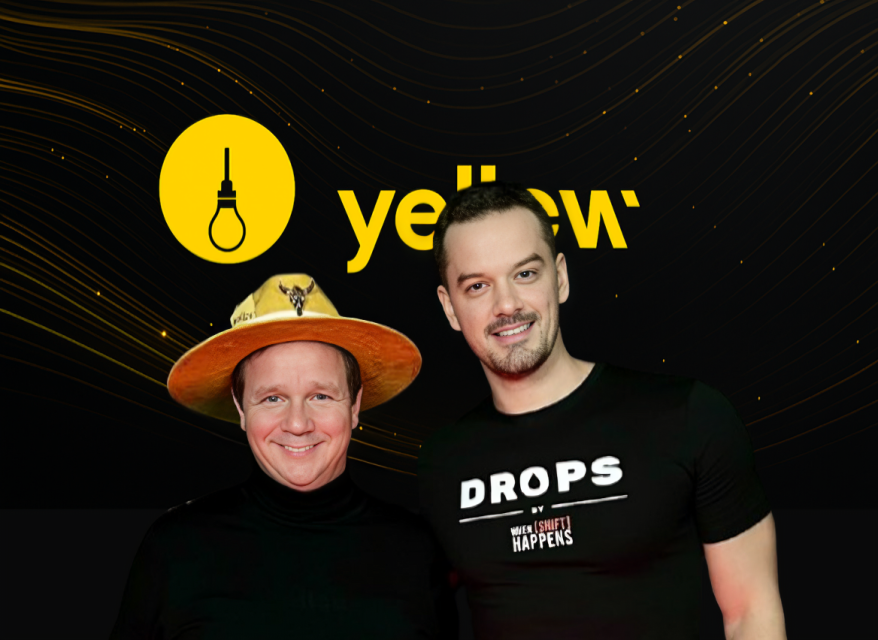Why Crypto Still Isn’t Trustless, and How Yellow Plans to Fix It - Alexis Sirkia
In this episode of DROPS, I sit down with Alexis Sirkia to discuss why he walked away from a billion-dollar crypto market-making firm to build @Yellow Network, a project aiming to unlock institutional trading in crypto by eliminating counterparty risk.
We talk about the philosophical roots of Bitcoin, the problem of trust in trading, and why state channels might finally allow trustless rather than merely decentralised trading in crypto.
@AlexisYellow isn’t just another builder. He’s the “S” in GSR, one of the world’s largest market-making firms—larger, he claims, than Wintermute. But instead of riding out his legacy on a yacht, Alexis has dedicated the last six years to building Yellow Network, a Layer 3 protocol using state channels to bring trustless infrastructure to crypto trading.
Why? Because as he puts it, “What Bitcoin is to payments, Yellow is to trading, and trading is ten times bigger than payments.”
Completing Satoshi’s Vision
Alexis’s story begins, as many in crypto do, with Satoshi Nakamoto. Bitcoin revolutionised payments by removing the need to trust governments or banks. Ethereum went further, removing trust from contracts. But trading, Alexis says, still requires trust, especially when done on centralised exchanges that can go bankrupt or disappear overnight.
“You still have to trust the counterparty,” Alexis explains. And that’s the problem Yellow solves by removing the need to trust, the same way Bitcoin removed trust from money.”
But this isn’t just about decentralisation for decentralisation’s sake. For Alexis, trust is a bottleneck to innovation. “We only trade and do business with people we trust,” he says. “But that limits the scale of collaboration and growth. Imagine if we didn't need to trust anyone and the result was guaranteed.”
The Leap from GSR to Yellow
So why leave GSR at all? Alexis could’ve easily retired, and sailed away, but instead, he doubled down on a hard, messy infrastructure problem.
“I spent years just articulating the problem,” he says. “Then I merged with another company, and we began building. It’s like when Apple introduced the iPod. It wasn’t just a product; they had to transform an entire industry.”
And Alexis is all in. He even convinced his own mother to invest €30,000 in Yellow. “I told her, ‘What Bitcoin is to payments, Yellow is to trading.’ That’s all she needed to hear.”
The Power of State Channels
The core technology powering Yellow is something called state channels, a Layer 3 solution that allows two parties to transact rapidly and securely without constantly recording every step on-chain. Alexis explains it using a simple metaphor:
“Imagine going to the same coffee shop every day. You could pay for each coffee individually, or you could run a tab and settle once at the end. That’s what state channels do.”
In practical terms, state channels allow two trading parties to lock up collateral in a smart contract and then stream profits or losses between each other in real time. There’s no need to trust that the other party will pay up because the smart contract handles everything.
“So you don't have to worry about me walking away and not paying you because the money is being streamed,” Alexis says. “The system is constantly streaming the profit or loss based on the trades. That is what state channels are. It's like this flow in and out.”
Why Lightning Didn’t Work, And Yellow Will
If state channels sound familiar, it’s because the Lightning Network tried something similar for Bitcoin payments. But as Alexis explains, it never took off.
“Streaming money wasn’t a real use case,” he says. “Streaming profit is. And Lightning was horribly capital inefficient, you needed $500 in a circuit to send $100.”
By contrast, trading is exactly where this tech makes sense. Billions of dollars are at stake, and institutional players are desperate for a way in that doesn’t require trusting opaque protocols.
Alexis confirms that major players like @chrislarsensf of Ripple, and @paoloardoino of Tether understand how significant state channels will be, and Chris is already invested in the Yellow Network.
“Brokers are literally lining up to be the first.” Alexis says. “Yellow Network is like being early to the NASDAQ or the New York Stock Exchange.”
Yellow’s Place in the Stack
In a crypto world crowded with networks and layers, where exactly does Yellow fit? Alexis calls it a Layer 3 solution. If Bitcoin is “in numbers we trust,” and Ethereum is “arbitration without humans,” then Yellow is “trustless trading infrastructure”—the final piece.
“We’re building this highway connecting traditional finance, online brokers, high frequency traders into the crypto ecosystem,” he explains.
And that’s the opportunity: to do for trading what NASDAQ did for equities, but in a decentralised and globally accessible way. Alexis compares being early to Yellow to being early to the NYSE or Google. “The people who help build the rules are the ones who benefit most,” he says. “It’s an industry revolution, and institutions know it.”
A Revolution Worth Building
When asked why he’s dedicating his life to Yellow instead of relaxing on a boat, Alexis doesn’t hesitate. “It’s a responsibility. Once you know a solution exists, you have to help bring it into the world.”
Despite the deep tech behind Yellow, he’s constantly focused on making it accessible. And in fact, he did. His mother is also an investor in Yellow. That human connection drives Alexis; he's not building abstract infrastructure. He’s building a future where people he loves can safely trade and invest in crypto without fear.
Final Thoughts
Yellow Network is on a mission to remove risk from trading and unlock a new era of institutional adoption. Backed by crypto OGs and traditional finance veterans, Alexis Sirkia is betting that trustless infrastructure is the next massive unlock.
The same way Satoshi sparked a revolution in money, Alexis wants to spark one in markets. And if Yellow succeeds, we might one day look back and say: this was the moment when crypto became safe for everyone.

17.7K
341
The content on this page is provided by third parties. Unless otherwise stated, OKX is not the author of the cited article(s) and does not claim any copyright in the materials. The content is provided for informational purposes only and does not represent the views of OKX. It is not intended to be an endorsement of any kind and should not be considered investment advice or a solicitation to buy or sell digital assets. To the extent generative AI is utilized to provide summaries or other information, such AI generated content may be inaccurate or inconsistent. Please read the linked article for more details and information. OKX is not responsible for content hosted on third party sites. Digital asset holdings, including stablecoins and NFTs, involve a high degree of risk and can fluctuate greatly. You should carefully consider whether trading or holding digital assets is suitable for you in light of your financial condition.

